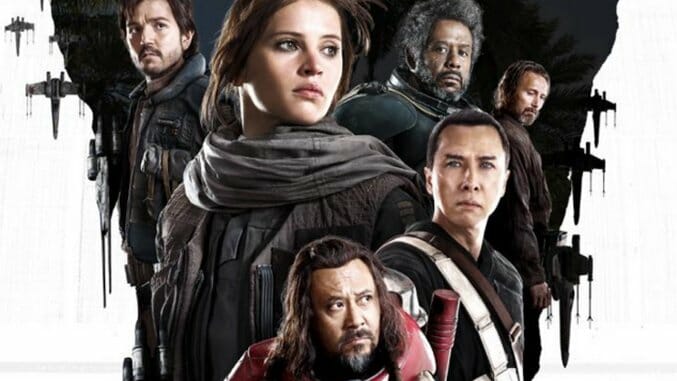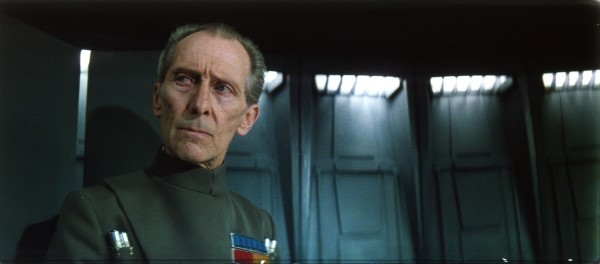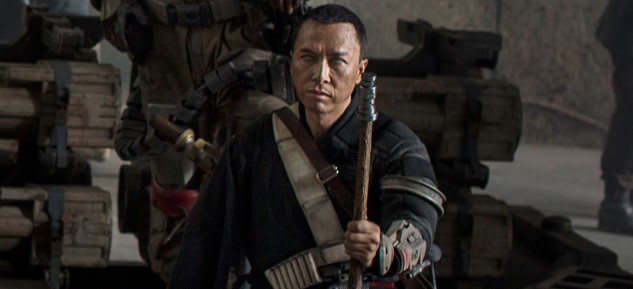Rogue One

When Rogue One: A Star Wars Story was announced as the first of several planned “Star Wars Anthology” films outside of the series’ main “Episode”-based chronology, fans could be forgiven if “cash-in” was the first phrase that swam to mind. This is Disney, after all—they’re by no means averse to the business of making billions of dollars. If they thought that there was money to be made in opening an actual Imperial Academy and training little kids to fire their blasters wildly in “Stormtrooper Marksmanship 101,” they’d almost certainly pull the trigger on that venture. But the point is this: There was at least reasonable cause to doubt that the magic of Star Wars could survive outside the world of the “Episodes.”
Fear not, for Rogue One is here to allay those concerns. Gareth Edwards’ venture into a galaxy far, far away is the Star Wars film we never knew we needed. It’s a triumphantly thrilling, serious-minded war movie that is incalculably stronger for the fact that it’s NOT the first chapter in a new franchise. Rogue One is a complete film in a way that no other Star Wars movie other than A New Hope is capable of being. It doesn’t “set the stage” for an inevitable next installment, and its characters are all the realer for the fact that they’re not perpetually sheathed in blasterproof Franchise Armor. It is, so help me, a satisfyingly complete story, and I had no idea until I watched the film how refreshing that concept would be.
Our protagonist is Jyn Erso (Felicity Jones), a plucky young woman whose brilliant scientist father (Mads Mikkelsen) has been controlled throughout her life by the Empire and coerced into designing superweapons of the moon-sized, planet-killing variety. Forced into a young adulthood on the fringes of the Rebel Alliance, she’s assembled a Jack Sparrow-esque rap sheet and, as the film begins, finds herself in Imperial prison on various petty charges. Sprung by the rebels (who all carry themselves like serious badasses, by the way), she’s sucked into a mission involving her father, the newly completed Death Star and a cast of resistance fighters and idealists all opposing the Empire in one way or another. It’s often been said that George Lucas’ original work mirrors the likes of Kurosawa and spaghetti westerns, and that’s never been more true than in Rogue One as it slowly assembles its team. It exists in very much the same thematic space as Seven Samurai, The Magnificent Seven or The Dirty Dozen.
By way of tempering praise: The first act is a little schizophrenic. Compared to the likes of A New Hope or Empire Strikes Back, which assemble almost all of their characters in one or two locations when we join the story, Rogue One initially feels disjointed. It’s clear why printed location names are shown on screen to introduce settings throughout, because the film opens with some rather hyperkinetic pinballing from place to place—six different planets/locations in the space of about 15 minutes as we establish characters and future set pieces. The storytelling here is economical, but the film really falls into its groove once Jyn begins tackling her mission in earnest.
If there’s one area where Rogue One excels throughout, though, it’s in the way it truly evokes the dingy, lived-in Star Wars universe. The sterile precision and modernism of the Empire, with its sleek ships and neatly starched uniforms, is beautifully counterpointed by the ancient, dirt-crusted fringe of a planet like Jedha, wherein the galaxy’s myriad alien races all seem to eke out a living. The scenes of this film that unfold on the dusty streets or neon-lit cityscapes of trading posts do a far better, more organic job of paying tribute to the multiculturalism and diaspora of alien cultures of this universe that The Force Awakens largely tried to cram into its New Hope-evoking cantina scene. Likewise with the film’s many wink-and-a-nod cameos of minor characters from the history of the the franchise—my favorite being so-called “Walrus Man” Ponda Baba, of all people. That sort of fan service might be eye-rolling to some, but it’s simple fun for the sake of fun.
One thing there’s certain to be much discussion about in the wake of the film’s release is the revival of key characters from A New Hope via CGI doppelgangers. I’ll mention only the most prominent and important: Grand Moff Tarkin, haughtily played in the original by the great Peter Cushing of Hammer Horror fame. Considering the inherent oddity of recreating both an iconic character’s face and voice from whole cloth, one might expect him to be used as nothing more than a passing cameo, but Tarkin is legitimately a major supporting player in this film, as any Star Wars geek would hope for in a film that revolves around the Death Star. And it’s … more than a little odd, at least at first. CGI has come a long, long way, but there’s something about recreating the familiar face of a dead actor that is inherently different, in terms of the uncanny valley factor, than creating an entirely new CGI character. It’s initially difficult to accept this Tarkin, but then another odd thing happens—he starts talking, and the old Peter Cushing lines (he even rolls the “Rs” just right) snap you back into the mindset of a kid watching A New Hope for the first time. By the end of the film, I’d entirely gotten over the initial weirdness, and legitimately wanted to see more Tarkin. Hopefully, any living relatives of Peter Cushing will agree.
 You don’t mess with the Moff.
You don’t mess with the Moff.
-

-

-

-

-

-

-

-

-

-

-

-

-

-

-

-

-

-

-

-

-

-

-

-

-

-

-

-

-

-

-

-

-

-

-

-

-

-

-

-

 Shoddy stormtrooper armor is no mach for that wooden stick.
Shoddy stormtrooper armor is no mach for that wooden stick.






































